The most haunting and poignant image of Irish involvement in the first World War is at the centre of an unsolved art mystery.
The Last General Absolution of the Munsters at Rue du Bois – a painting long presumed lost – depicts soldiers of the Royal Munster Fusiliers regiment receiving “general absolution” from their chaplain on the eve of battle in May 1915. Most of them died within 24 hours.
The painting, by Italian-born war artist Fortunino Matania, became one of the most famous images of the war when prints of it were published in illustrated weekly newspapers.
Copies hung in houses & pubs throughout Ireland, and especially Munster, but, as Irish public opinion towards the war changed, the picture gradually disappeared from view.A copy still hangs in the famous pub Larkins of Garrykennedy Co Tipperary to this day.
Centenary commemorations of the first World War have prompted renewed interest in the whereabouts of the original painting among art and military historians.
A widely held theory that the painting was lost when archives were destroyed in a fire during the blitz of London in 1940 is “very much” doubted by English historian Lucinda Gosling, who is writing a book about the artist.
She told The Irish Times there was no definitive proof to confirm this theory and it was possible the original painting was still “out there”.
The painting could, conceivably, be in private hands or, more improbably, be lying forgotten or miscatalogued in a museum’s storage area. Matania’s work occasionally turns up at art auctions, but there has been no known or publicly-documented sighting of the original Munsters painting.
Ms Gosling described Matania as an artist “able to work at great speed, producing pictures that were unnervingly photographic in their realism”.
His pictures, she said, had “reached and influenced millions” and “he combined skill and artistry with a strong streak of journalistic tenacity”.
Wayside shrine
The painting is based on an event that took place on Saturday evening, May 8th, 1915.The painting is imbued with a sense of impending doom.
In Catholic canon law, a priest may grant general absolution of sin to a gathering of the faithful where there is imminent danger of death and no time for individual confessions.
In the painting, the Irish chaplain Fr Francis Gleeson is shown blessing the men: “Misereatur vestri omnipotens Deus; et dimissis omnibus peccatis vestris, perducat vos Iesus Christus ad vitam aeternam” (May Almighty God have mercy on you, and having forgiven all your sins, may Jesus Christ bring you to life everlasting).
The men then sang the hymns Te Deum and Hail Glorious St Patrick.
The artist was not present at the scene but based his painting on a written account by Lieut- Col Rickard’s widow, Jessie, who is believed to have commissioned the painting in memory of her husband.
She had gathered eye-witness accounts from survivors and wrote: “There are many journeys and many stopping- places in the strange pilgrimage we call life, but there is no other such journey in the world as the journey up a road on the eve of battle, and no stopping- place more holy than a wayside shrine.”
She noted among the troops were “lads from Kerry and Cork, who, a year before, had never dreamed of marching in the ranks of the British army”.
“The Munsters were wild with enthusiasm; they were strong with the invincible strength of faith and high hope, for they had with them the vital conviction of success, the inspiration that scorns danger – which is the lasting heritage of the Irish; theirs still and theirs to remain when great armaments and armies and empires shall be swept away, because it is immovable as the eternal stars.”
Mown down
The following morning, Sunday May 9th, most of the Irish soldiers were mown down by German gunfire and shelling.
On a catastrophic day for the British army – over 11,000 casualties – the Royal Munster Fusiliers suffered dreadful losses. Exact estimates vary, but one account records 800 Munsters went into battle and only 200 assembled that evening.
Mrs Rickard concluded : “So the Munsters came back after their day’s work; they formed up again in the Rue du Bois, numbering 200 men and three officers. It seems almost superfluous to make any further comment.”
The Last General Absolution of the Munsters at Rue du Bois
The Painting
The Last General Absolution of the Munsters at Rue du Bois shows some of the hundreds of soldiers from the second battalion of the Royal Munster Fusiliers who gathered at a shrine near the village of Rue du Bois on the western front on Saturday, May 8th, 1915.
The image was published in the London illustrated weekly newspaper The Sphere in November 1916, and in 1917 in the Weekly Freeman’s, an Irish publication. There are copies of the print in various museums and in private ownership in Ireland and Britain.
The Artist
Fortunino Matania, (1881- 1963) was born in Naples and was a well-known artist and illustrator in Italy before moving to London in 1902. He worked for The Sphere – an illustrated weekly newspaper – and became famous for depicting the sinking of the Titanic in 1912.
He was an official war artist in the first World War and his graphic illustrations of trench warfare were highly renowned.
The Location
Rue du Bois is located near the village of Neuve Chapelle in the Nord-Pas-de-Calais region of France close to the border with Belgium. According to the Royal Munster Fusiliers Association, the original shrine has long gone.
The Chaplain
Depicted on horseback, with hand raised granting general absolution, is Fr Francis Gleeson, a native of Templemore, Co Tipperary. He was ordained a priest in Maynooth in 1910 and volunteered to serve as a chaplain in the army at the outbreak of the war. He was assigned to the Royal Munster Fusiliers and served with distinction. He survived the war and returned to Ireland where he worked as priest in Dublin and died in 1959.
The Commanding Officer
Lieut-Col Victor Rickard, the other man on horseback, was born in Englandto an Irish father and English mother.
He was the commander of the battalion. He died in action the next day, aged 40.
The Patron
Lieut-Col Rickard’s widow Jessie, who is believed to have commissioned the painting, was the daughter of a Church of Ireland clergyman who spent her youth in Mitchelstown, Co Cork. She became a well-known novelist and published some 40 books.
After the war she converted to Catholicism under the guidance of another former chaplain in the British army in the first World War – Fr Joseph Leonard, who later befriended Jackie Kennedy.
Mrs Rickard died at Montenotte, Cork, in 1963, aged 86.





 52cm x 60cm Coonagh Co Limerick
52cm x 60cm Coonagh Co Limerick













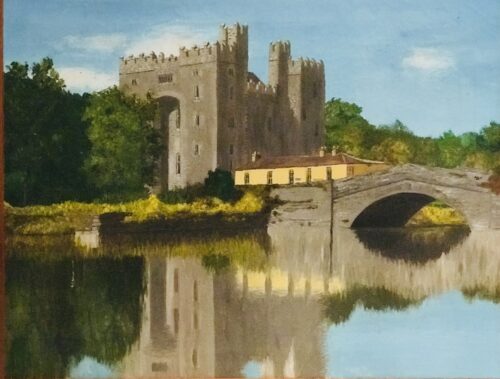
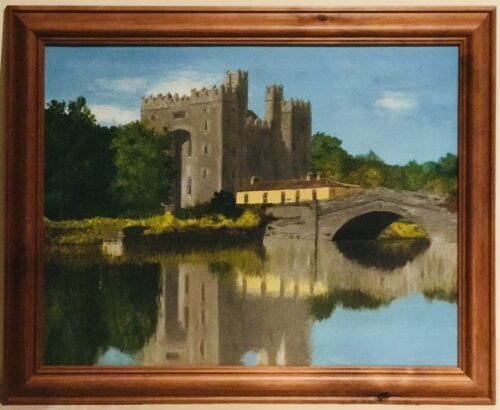






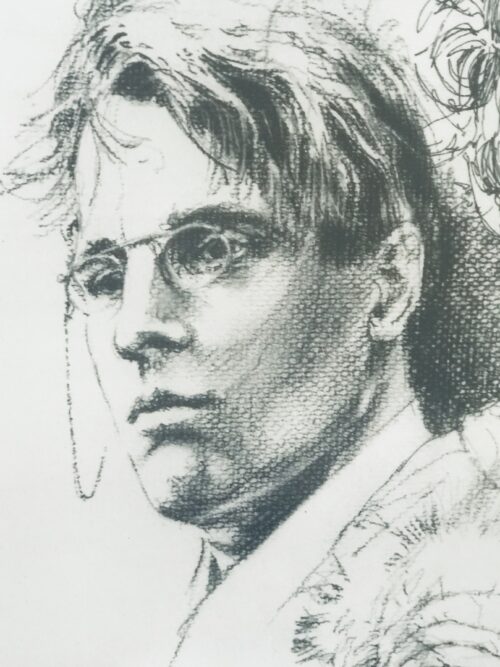
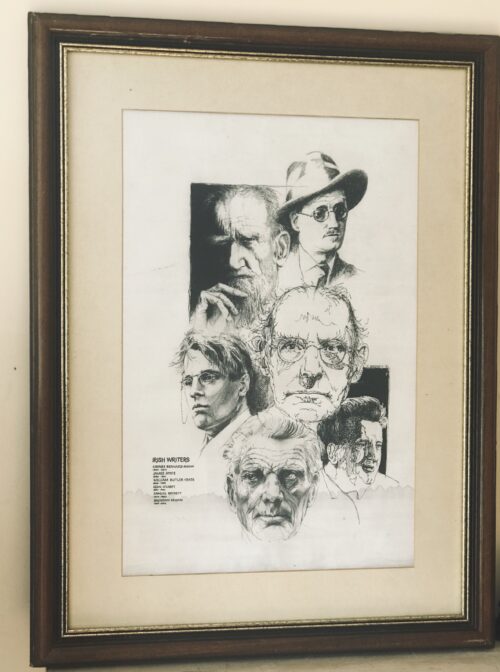
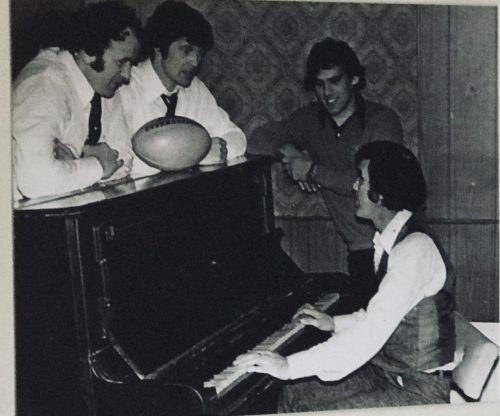
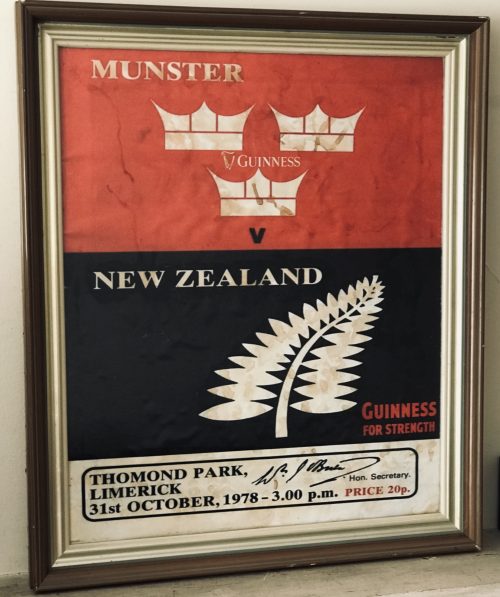

 Many years on, Stuart Wilson vividly recalled the Dennison tackles and spoke about them in remarkable detail and with commendable honesty: “The move involved me coming in from the blind side wing and it had been working very well on tour. It was a workable move and it was paying off so we just kept rolling it out. Against Munster, the gap opened up brilliantly as it was supposed to except that there was this little guy called Seamus Dennison sitting there in front of me.
“He just basically smacked the living daylights out of me. I dusted myself off and thought, I don’t want to have to do that again. Ten minutes later, we called the same move again thinking we’d change it slightly but, no, it didn’t work and I got hammered again.”
The game was 11 minutes old when the most famous try in the history of Munster rugby was scored.
Tom Kiernan recalled: “It came from a great piece of anticipation by Bowen who in the first place had to run around his man to get to Ward’s kick ahead. He then beat two men and when finally tackled, managed to keep his balance and deliver the ball to Cantillon who went on to score. All of this was evidence of sharpness on Bowen’s part.”
Very soon it would be 9-0. In the first five minutes, a towering garryowen by skipper Canniffe had exposed the vulnerability of the New Zealand rearguard under the high ball. They were to be examined once or twice more but it was from a long range but badly struck penalty attempt by Ward that full-back Brian McKechnie knocked on some 15 yards from his line and close to where Cantillon had touched down a few minutes earlier. You could sense White, Whelan, McLoughlin and co in the front five of the Munster scrum smacking their lips as they settled for the scrum. A quick, straight put-in by Canniffe, a well controlled heel, a smart pass by the scrum-half to Ward and the inevitability of a drop goal. And that’s exactly what happened.
The All Blacks enjoyed the majority of forward possession but the harder they tried, the more they fell into the trap set by the wily Kiernan and so brilliantly carried out by every member of the Munster team.
The tourists might have edged the line-out contest through Andy Haden and Frank Oliver but scrum-half Mark Donaldson endured a miserable afternoon as the Munster forwards poured through and buried him in the Thomond Park turf.
As the minutes passed and the All Blacks became more and more unsure as to what to try next, the Thomond Park hordes chanted “Munster-Munster–Munster” to an ever increasing crescendo until with 12 minutes to go, the noise levels reached deafening proportions.
And then ... a deep, probing kick by Ward put Wilson under further pressure. Eventually, he stumbled over the ball as it crossed the line and nervously conceded a five-metre scrum. The Munster heel was disrupted but the ruck was won, Tucker gained possession and slipped a lovely little pass to Ward whose gifted feet and speed of thought enabled him in a twinkle to drop a goal although surrounded by a swarm of black jerseys. So the game entered its final 10 minutes with the All Blacks needing three scores to win and, of course, that was never going to happen.
Munster knew this, so, too, did the All Blacks. Stu Wilson admitted as much as he explained his part in Wardy’s second drop goal: “Tony Ward banged it down, it bounced a little bit, jigged here, jigged there, and I stumbled, fell over, and all of a sudden the heat was on me. They were good chasers. A kick is a kick — but if you have lots of good chasers on it, they make bad kicks look good. I looked up and realised — I’m not going to run out of here so I just dotted it down. I wasn’t going to run that ball back out at them because five of those mad guys were coming down the track at me and I’m thinking, I’m being hit by these guys all day and I’m looking after my body, thank you. Of course it was a five-yard scrum and Ward banged over another drop goal. That was it, there was the game”.
The final whistle duly sounded with Munster 12 points ahead but the heroes of the hour still had to get off the field and reach the safety of the dressing room. Bodies were embraced, faces were kissed, backs were pummelled, you name it, the gauntlet had to be walked. Even the All Blacks seemed impressed with the sense of joy being released all about them. Andy Haden recalled “the sea of red supporters all over the pitch after the game, you could hardly get off for the wave of celebration that was going on. The whole of Thomond Park glowed in the warmth that someone had put one over on the Blacks.”
Controversially, the All Blacks coach, Jack Gleeson (usually a man capable of accepting the good with the bad and who passed away of cancer within 12 months of the tour), in an unguarded (although possibly misunderstood) moment on the following day, let slip his innermost thoughts on the game.
“We were up against a team of kamikaze tacklers,” he lamented. “We set out on this tour to play 15-man rugby but if teams were to adopt the Munster approach and do all they could to stop the All Blacks from playing an attacking game, then the tour and the game would suffer.”
It was interpreted by the majority of observers as a rare piece of sour grapes from a group who had accepted the defeat in good spirit and it certainly did nothing to diminish Munster respect for the All Blacks and their proud rugby tradition.
Many years on, Stuart Wilson vividly recalled the Dennison tackles and spoke about them in remarkable detail and with commendable honesty: “The move involved me coming in from the blind side wing and it had been working very well on tour. It was a workable move and it was paying off so we just kept rolling it out. Against Munster, the gap opened up brilliantly as it was supposed to except that there was this little guy called Seamus Dennison sitting there in front of me.
“He just basically smacked the living daylights out of me. I dusted myself off and thought, I don’t want to have to do that again. Ten minutes later, we called the same move again thinking we’d change it slightly but, no, it didn’t work and I got hammered again.”
The game was 11 minutes old when the most famous try in the history of Munster rugby was scored.
Tom Kiernan recalled: “It came from a great piece of anticipation by Bowen who in the first place had to run around his man to get to Ward’s kick ahead. He then beat two men and when finally tackled, managed to keep his balance and deliver the ball to Cantillon who went on to score. All of this was evidence of sharpness on Bowen’s part.”
Very soon it would be 9-0. In the first five minutes, a towering garryowen by skipper Canniffe had exposed the vulnerability of the New Zealand rearguard under the high ball. They were to be examined once or twice more but it was from a long range but badly struck penalty attempt by Ward that full-back Brian McKechnie knocked on some 15 yards from his line and close to where Cantillon had touched down a few minutes earlier. You could sense White, Whelan, McLoughlin and co in the front five of the Munster scrum smacking their lips as they settled for the scrum. A quick, straight put-in by Canniffe, a well controlled heel, a smart pass by the scrum-half to Ward and the inevitability of a drop goal. And that’s exactly what happened.
The All Blacks enjoyed the majority of forward possession but the harder they tried, the more they fell into the trap set by the wily Kiernan and so brilliantly carried out by every member of the Munster team.
The tourists might have edged the line-out contest through Andy Haden and Frank Oliver but scrum-half Mark Donaldson endured a miserable afternoon as the Munster forwards poured through and buried him in the Thomond Park turf.
As the minutes passed and the All Blacks became more and more unsure as to what to try next, the Thomond Park hordes chanted “Munster-Munster–Munster” to an ever increasing crescendo until with 12 minutes to go, the noise levels reached deafening proportions.
And then ... a deep, probing kick by Ward put Wilson under further pressure. Eventually, he stumbled over the ball as it crossed the line and nervously conceded a five-metre scrum. The Munster heel was disrupted but the ruck was won, Tucker gained possession and slipped a lovely little pass to Ward whose gifted feet and speed of thought enabled him in a twinkle to drop a goal although surrounded by a swarm of black jerseys. So the game entered its final 10 minutes with the All Blacks needing three scores to win and, of course, that was never going to happen.
Munster knew this, so, too, did the All Blacks. Stu Wilson admitted as much as he explained his part in Wardy’s second drop goal: “Tony Ward banged it down, it bounced a little bit, jigged here, jigged there, and I stumbled, fell over, and all of a sudden the heat was on me. They were good chasers. A kick is a kick — but if you have lots of good chasers on it, they make bad kicks look good. I looked up and realised — I’m not going to run out of here so I just dotted it down. I wasn’t going to run that ball back out at them because five of those mad guys were coming down the track at me and I’m thinking, I’m being hit by these guys all day and I’m looking after my body, thank you. Of course it was a five-yard scrum and Ward banged over another drop goal. That was it, there was the game”.
The final whistle duly sounded with Munster 12 points ahead but the heroes of the hour still had to get off the field and reach the safety of the dressing room. Bodies were embraced, faces were kissed, backs were pummelled, you name it, the gauntlet had to be walked. Even the All Blacks seemed impressed with the sense of joy being released all about them. Andy Haden recalled “the sea of red supporters all over the pitch after the game, you could hardly get off for the wave of celebration that was going on. The whole of Thomond Park glowed in the warmth that someone had put one over on the Blacks.”
Controversially, the All Blacks coach, Jack Gleeson (usually a man capable of accepting the good with the bad and who passed away of cancer within 12 months of the tour), in an unguarded (although possibly misunderstood) moment on the following day, let slip his innermost thoughts on the game.
“We were up against a team of kamikaze tacklers,” he lamented. “We set out on this tour to play 15-man rugby but if teams were to adopt the Munster approach and do all they could to stop the All Blacks from playing an attacking game, then the tour and the game would suffer.”
It was interpreted by the majority of observers as a rare piece of sour grapes from a group who had accepted the defeat in good spirit and it certainly did nothing to diminish Munster respect for the All Blacks and their proud rugby tradition.

